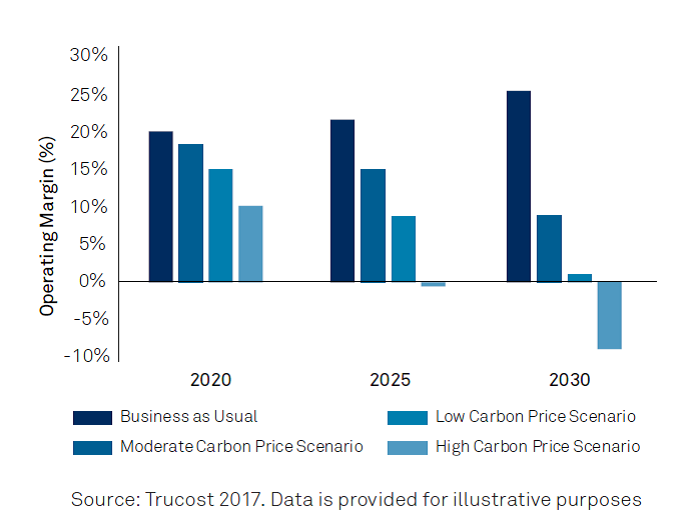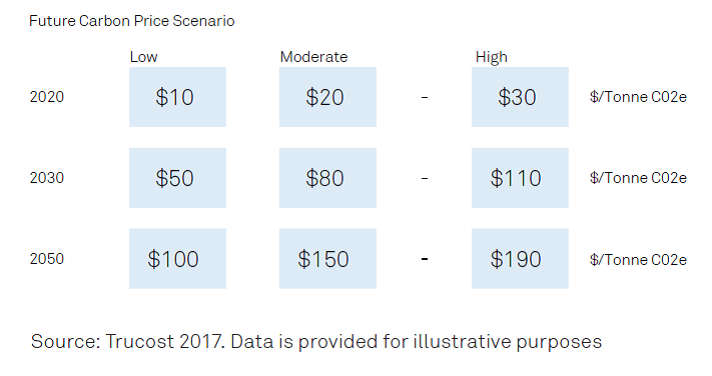In light of increasing investor pressure on companies to disclose on ESG issues, risk assessment tools can play a key role in quantifying a company’s financial exposure, Libby Bernick writes.
Companies face a host of unpriced regulatory, physical and market risks from environmental, social, and governance (ESG) issues. Climate-related impacts such as extreme weather and water crises have been identified by the World Economic Forum as top ESG risks. Trucost, part of S&P Dow Jones Indices, calculates that average carbon prices could increase more than sevenfold to USD 120 per metric ton by 2030, as regulations are introduced to achieve the Paris Agreement goal to limit global warming to 2°C.
Companies are under growing pressure from investors to disclose these risks and how they may affect their financial performance. The recent recommendations by the Financial Stability Board’s Task Force on Climate-related Financial Disclosures, with its membership of 32 global experts from finance and industry chaired by Michael Bloomberg, says that companies should conduct scenario analysis of how resilient their business strategy is to climate-related risks.
Shareholders are showing increasing support for resolutions calling on carbon-intensive companies to assess and disclose the risks associated with a low-carbon transition consistent with the Paris Agreement’s 2°C target (see exhibit 1). In 2017, these resolutions received an average vote outcome of 45% in favor compared to 33% in 2016, according to the Principles of Responsible Investment. The AGMs of ExxonMobil, Occidental and PPL Corporation saw a majority of investors support two-degree scenario resolutions, voting against management recommendations.
Exhibit 1: Stress test your business model against future carbon regulation scenarios

The transition to a low-carbon economy could create many opportunities for companies including energy security and the potential to increase revenue from low-carbon technologies, products and services. Car manufacturers like Volvo and GM are turning to electric and hybrid engines to reduce carbon emissions and air pollution caused by diesel cars.
As a leading provider of ESG information for almost 20 years and now part of S&P Dow Jones Indices, Trucost knows that companies and their investors need the data and tools to be able to understand what climate-related risks and opportunities mean in practical business terms. This is why Trucost recently launched its Corporate Carbon Pricing Tool.
For the nearly 1,200 companies that the CDP says have set an internal price on carbon or are committed to doing so in 2017, the tool provides the data to set an appropriate price taking into account a company’s business activities. Other companies that may not want to set an internal price but want to understand their cost exposure, will find the tool helpful for understanding the financial implications of carbon pricing now, and in the future (see exhibit 2).
Exhibit 2: Benchmark internal carbon price to account for future potential increases in carbon pricing regulation across operating geographies

The easy to use, desktop tool is designed for companies in all sectors and can be applied across a whole enterprise or a specific region or operation. It provides companies with insights into how carbon prices could increase in the future under a range of scenarios and in different regions around the world, and what this could mean for their business. By quantifying current and future financial risk exposure to regional carbon pricing mechanisms, the Corporate Carbon Pricing Tool enables companies to stress test company financials, adopt a carbon shadow price, or prioritize low-carbon innovation where it most matters.
Companies want to understand how the risks they face from increasing carbon prices compare to their peers. For many businesses, this can be an important factor driving companies to reduce carbon emissions so they stay competitive. Reputation is another important driver. Many companies see an advantage in taking a proactive position on climate change to inform communications to customers, shareholders and policymakers. The Corporate Carbon Pricing Tool provides companies with the benchmarking data they need to inform these strategic decisions.
Trucost also applies the concept of pricing risks to other ESG issues. Water scarcity and pollution is a major concern for many companies, especially those in water-intensive sectors such as food and drink. In 2016, for example, 607 of the world’s largest businesses responding to the CDP’s Global Water Program questionnaire reported exposure to water risks totaling more than US$14 billion. Most listed companies do not disclose water-related financial risks, and the total unpriced risk is estimated by Trucost to be US$439 billion.
In partnership with Ecolab and Microsoft, Trucost developed the Water Risk Monetizer a publicly available global water risk assessment tool that uses best-in-class local water basin datasets and scientific methodologies to monetize water-specific business risks. It provides a comprehensive series of metrics to help businesses understand water-related risks by using economic techniques to quantify the risks in financial terms.
The Corporate Carbon Pricing Tool and Water Risk Monetizer are helping sustainability directors, CFOs, facility managers and product design teams to understand their exposure to unpriced ESG risks and inform the investment case for sustainable products and business models.
Libby Bernick, Global Head of Corporate Business, Trucost, part of S&P Dow Jones Indices.






Great post, Libby. Thanks for summarizing recent developments.